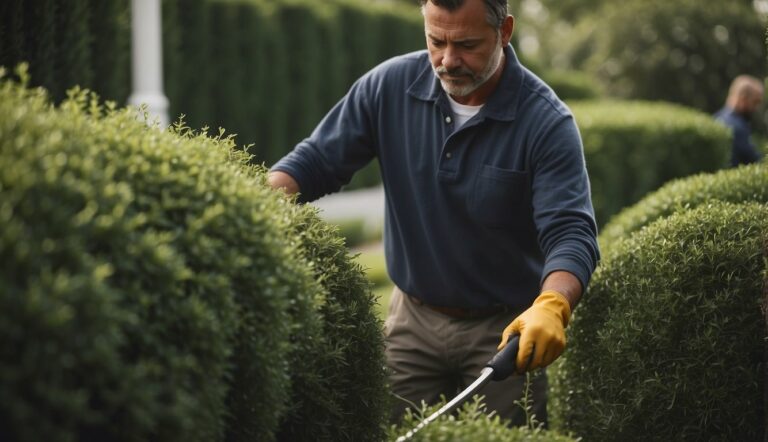Healthy, lush grass is the hallmark of a well-maintained lawn. At our local landscaping service company, we understand that achieving the vibrant green yard of your dreams begins with a critical process called lawn aeration. This service is designed to combat soil compaction and thatch buildup, allowing air, water, and nutrients to reach the roots of your grass more effectively.
As seasoned experts in lawn care, we advocate for aeration as an essential part of a comprehensive lawn maintenance regimen. Aeration involves the removal of small soil plugs from your lawn, which improves the soil structure and promotes root growth. For areas with dense clay soil or lawns subject to heavy foot traffic, aeration is especially beneficial in encouraging a hardier, more robust lawn.
Our approach to aeration is tailored to the unique needs of each lawn we service. By removing these small cores from the soil, we not only facilitate better absorption of water and fertilizer but also prepare your lawn for overseeding, which can lead to a denser, more vibrant turf. With our professional aeration services, your lawn can achieve the health and beauty it deserves.
What Is Lawn Aeration?

As experts in the field of landscaping and dedicated owners of a local landscaping service, we know that a healthy lawn is the foundation of a beautiful yard. Here we’ll explain the process of lawn aeration, its vital role in lawn care, and how to identify when your lawn is in need of this essential service.
What Is Lawn Aeration?
Lawn aeration is the process we use to perforate the soil with small holes, allowing air, water, and nutrients to penetrate the grass roots. This helps the roots grow deeply and produce a stronger, more vigorous lawn. We typically use specialized aeration equipment to remove small plugs of thatch and soil to improve the soil structure.
The Importance of Aeration for Your Lawn
Aeration is crucial for maintaining a healthy lawn as it:
- Enhances oxygen circulation to grass roots.
- Improves water and nutrient uptake.
- Strengthens grass root systems for a more resilient lawn.
- Reduces soil compaction, allowing roots to expand and soil to absorb water more effectively.
- Aids in decomposing thatch, the layer of dead grass and roots that can suffocate live grass.
Identifying the Signs of Soil Compaction
Your lawn might need aeration if you notice:
- Pooling of water on the lawn surface after rain.
- Lawn feels spongy to walk on, which might indicate a thatch problem.
- Heavy foot traffic leading to compacted soil.
- Grass that doesn’t grow or recovery poorly from wear and tear.
Remember, as seasoned landscaping professionals, we see aeration as an indispensable part of lawn care that ensures your grass stays healthy and strong throughout the year.
Lawn Aeration Services
We understand the vital role that aeration plays in maintaining a healthy lawn. Through our landscaping expertise, we offer tailored solutions to enhance your lawn’s vitality and appearance.
Core Aeration vs. Spike Aeration Methods
Core Aeration:
- Removes small cores of soil from the lawn using a core or plug aerator
- Best for compacted soils and heavy clay, allowing air and water to penetrate deeper
Spike Aeration:
- Involves poking holes in the ground using a spike aerator
- Less effective for heavy soils but can be beneficial for a quick fix
The Benefits of Professional Lawn Aeration
Why Professional Aeration?
- Professional lawn aeration services provide expertise that DIY may not match
- Lawn specialists use efficient, commercial-grade aerators for the best results
Advantages:
- Enhances root growth
- Improves nutrient absorption
- Assists in thatch breakdown
Selecting the Right Time for Aeration
Best Timing for Aeration:
- Fall for cool-season grass
- Spring for warm-season grass
Optimization Table:
| Grass Type | Recommended Aeration Timeframe |
|---|---|
| Cool-Season Grass | Fall |
| Warm-Season Grass | Spring or Early Summer |
Investing in the right aeration method at the optimal time is crucial for lawn care success. As a local landscaping services company, we stress the importance of this service to keep your grass thriving throughout the year.
Pre-Aeration Lawn Care
Before aerating your lawn, it’s crucial to prepare it properly to ensure the aeration process is effective. We’ll guide you through the steps to ready your yard for aeration, addressing key elements such as thatch and the ideal groundwork for overseeding post-aeration.
Preparing Your Lawn for Aeration
To prepare your lawn, the first step is to ensure it is mowed to a shorter length than usual but do so without stressing the grass. This will facilitate the aerator’s ability to reach the soil and create openings for air and water. Water your lawn one to two days before aerating to soften the soil, making it easier for the aerator to penetrate. However, avoid overwatering, as this can make the soil too muddy and difficult to work with.
- Mow the lawn: Mow to a shorter length without causing stress to the grass.
- Irrigation: Water the lawn 1-2 days prior, ensuring moisture to soften the soil.
Addressing Thatch and Overseeding
Thatch is a layer of organic material between the green vegetation and soil surface. If the thatch layer is more than half an inch thick, aeration is recommended to improve nutrient uptake. Once you’ve aerated your lawn, it’s an ideal time to overseed. The open soil created by aeration is perfect for new grass seeds to germinate and grow, filling in any patchy areas and improving your lawn’s density.
- Thatch Inspection: Check thatch levels; more than ½ inch indicates a need for aeration.
- Post-Aeration Overseeding: Broadcast grass seed over the aerated lawn to encourage thick growth and fill in patches.
By following these guidelines, we set the stage for effective aeration that cultivates a lusher, healthier lawn.
Post-Aeration Lawn Maintenance
After aerating your lawn, taking the right maintenance steps ensures that grass roots receive the necessary nutrients and water, leading to a healthier, more drought-resistant lawn. Our team at the local landscaping service has seen firsthand how correct post-aeration care boosts lawn vitality.
Fertilizing After Aeration
Fertilizing immediately after aeration is effective because the nutrients can reach deeper into the soil. We recommend:
- Using a balanced fertilizer that provides essential nutrients like nitrogen, phosphorus, and potassium.
- Avoiding over-fertilization to prevent nutrient runoff and potential environmental harm.
| Fertilizer Type | Nitrogen (N) | Phosphorus (P) | Potassium (K) | Application Rate |
|---|---|---|---|---|
| Balanced | Medium | Medium | Medium | As per product instructions |
Remember, adding fertilizer helps in strengthening the grass and reducing the likelihood of weed invasion.
Watering and Drought Resistance
Proper irrigation after aeration helps maintain soil moisture, which is essential for root absorption of nutrients. To ensure efficient water use and improve drought resistance, we suggest:
- Watering the lawn within 24 to 48 hours after aeration to encourage deep root growth.
- Maintaining a light, but consistent watering schedule to prevent soil from becoming too waterlogged, which can encourage unwanted mushroom growth.
Keep the following in mind for optimal watering:
| Time of Day | Watering Duration | Frequency |
|---|---|---|
| Early Morning | 15-20 minutes | Daily for the first few days |
| Evening | Avoid evening watering | to prevent disease |
By following these post-aeration steps, your lawn will be better equipped to absorb water and nutrients, ultimately leading to a lush and resilient turf.
Cost and Considerations for Aeration
In our local landscaping services company, we’ve learned that understanding the cost and essential factors of lawn aeration services is pivotal for our customers. Ensuring a healthy and vibrant lawn is an investment in both time and money.
Evaluating the Cost of Aeration Services
Aeration, the process of puncturing the soil to improve water and nutrient absorption, typically has a cost range based on the area of the lawn. Here’s a quick overview of what you can expect:
- Small Lawns (<1,000 sq ft): Expect to pay around $0.10 to $0.35 per square foot.
- Large Lawns (>1,000 sq ft): Prices may shift to a per-acre rate, averaging $480 per acre.
- Overall Price: Most homeowners spend $75 to $250 for aeration services, with variables such as lawn size and soil condition affecting the final cost.
Aeration efficiency depends on the method employed, with core aeration being a popular choice due to its effectiveness. However, extra services, such as overseeding or fertilization, will add to the base cost. It’s crucial to match services to the specific needs of your region’s lawn care practices for the best results.
DIY Aeration vs. Hiring a Specialist
Deciding between DIY aeration and hiring a lawn care specialist requires weighing the costs against the time and effort involved. While the initial investment in DIY equipment may seem cost-efficient, consider the following:
- Time and Labor: Aeration is time-consuming and physically demanding.
- Equipment Cost: The purchase or rental of aeration equipment can be significant.
- Efficiency: Lawn specialists possess the expertise and equipment to aerate lawns swiftly and effectively.
On the other hand, hiring a specialist means:
- Professional Quality: Expect high-quality, efficient aeration, tailored to your lawn’s unique requirements.
- Convenience: Free up personal time while we handle the labor-intensive work.
Ultimately, while DIY can offer flexibility and savings, the convenience and guaranteed results from professionals often justify the investment for our clients. We recommend assessing lawn size, personal time availability, and desired outcome when choosing between these options.





